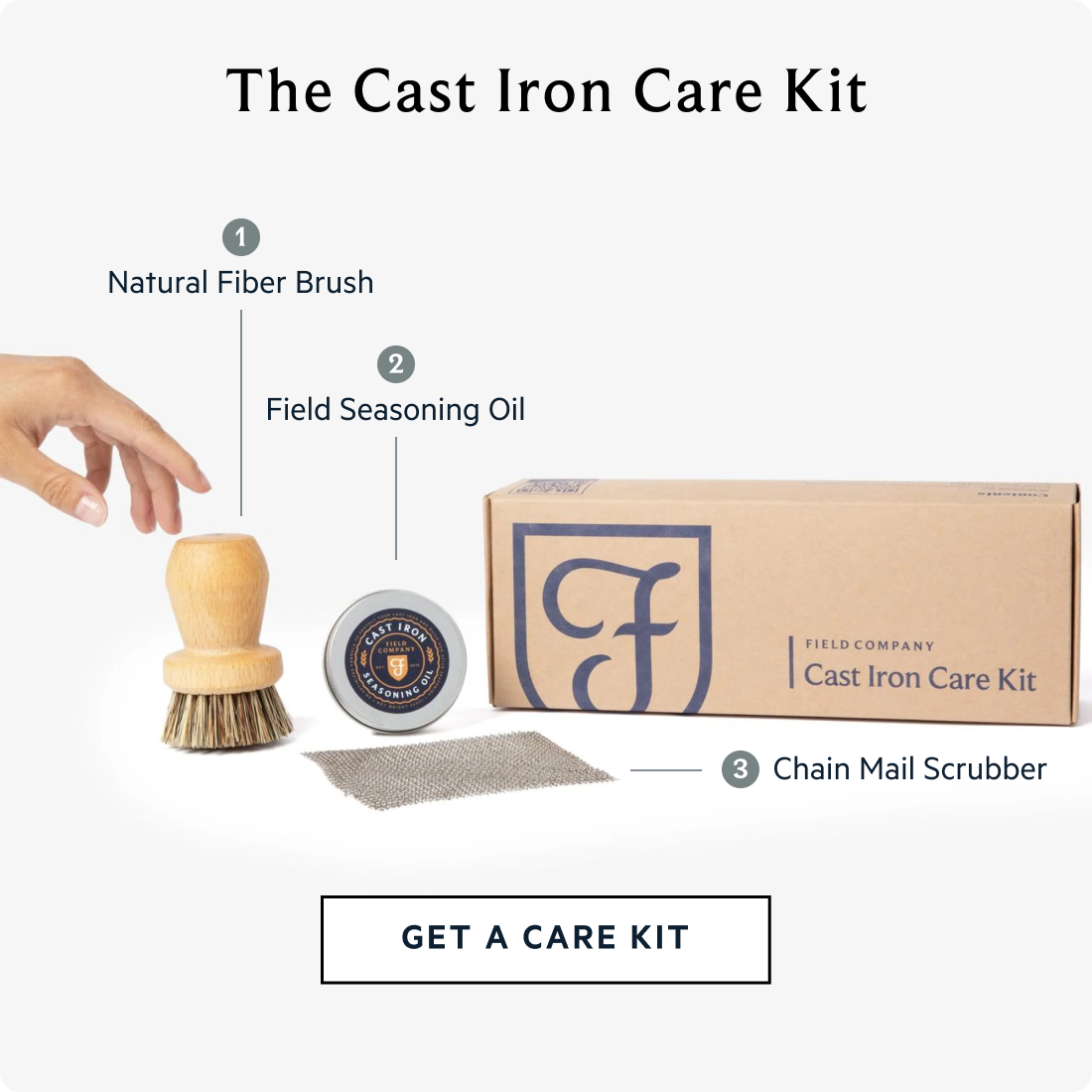The Shape of a Field Skillet
Good design is worth the risk.
The Field Skillet was born from a classical design sensibility, with a touch of sex appeal. We wanted to honor the proportions and performance that made vintage American cast iron legendary, while pushing modern manufacturing limits with our obsession over how our pans look and feel when you use them. The result is cast iron that's lighter, smoother, and more beautiful than anything made in the last century.
If you're not willing to take on some risk and creative tension, you end up with uninspiring designs—something our world increasingly experiences as we optimize for machines instead of human needs.
Our initial prototype leaned heavily into modern aesthetics—crisp lines, minimal radii, almost severe in its precision. It was designed to have a definite beginning and end, sitting perfectly flush on a countertop with sharp edges and sweeping curves.
The First Iteration (left), The Final Product (right).
It was undeniably striking, but the design was too unforgiving to manufacture at scale, with complex geometries that fought against, rather than worked with, our manufacturing partners.
This led us to our core design philosophy: push the absolute limits of what's possible without exceeding them. We work closely with craftspeople and machinery to find that sweet spot where ambition meets reality, where function meets form. The challenge is that manufacturers prefer safety margins. When you're making thousands of something, risk feels expensive. But if you're not willing to take on some of that risk and creative tension, you end up with uninspiring designs—something our world increasingly experiences as we optimize for machines instead of human needs.
The Shapes That Define Field
Every detail on a Field skillet has intent—to make your pan easier to use, more beautiful to look at, and better over time.
1. The Handle Architecture
We departed from the traditional teardrop for something with more substance. We still opted for a gradual widening and narrowing, but muted it a bit. We added more to hold onto in girth and length which makes the handle a more important part of the pan rather than an afterthought. The arch in the middle provides both a sensory input to the hand while using it, along with adding important visual interest. Take it away and the eye gets lost in overly severe minimalism. Read more about our handle here.
Cofounder Stephen carving out handle prototypes.
2. The Handle Connection
The way the underside of our handle connects to the pan body is a nod to wooden spoon carving. In wood, it's a technique for maintaining strength while reducing the bird's-eye width near the spoonhead to a pleasing proportion. In our pans, while it helps a little with strength, its main contribution is to provide a "trigger" where the pointer finger can rest naturally and comfortably. It's woodcraft principles applied to iron—form and function working in harmony.
3. The Helper Handle
A circular skillet can feel too minimal, almost incomplete. After eliminating pour spouts due to their lack of utility and extra hassle in manufacturing, our early prototypes felt like something was missing. The helper handle became our solution—a functional crown atop our pan that grows organically from the pan's circumference, mimicking the main handle's geometry while adding visual weight and practical balance. But it's more than aesthetic: when your skillet is loaded with food, you need two hands to move it safely. The helper handle gives you that crucial second resting point, making a heavy pan feel manageable and secure.
The helper handle has proven itself as a crucial feature time and time again.
4. The Sidewalls
Maine is a spiritual home for the Field family, and the state's craft tradition runs deep in our design DNA. The slope of our sidewalls draws inspiration from the elegant transom lines of classic sailboats—those curved overhangs that early America's Cup designers used to game the measurement rules. As boats heeled over, their waterlines lengthened and they could slice through waves faster. Our side walls also honor the proportions we studied in our favorite vintage American cast iron skillets. The flared opening makes flipping, stirring, and plating feel natural and the thin sidewalls reduce the overall weight of the pan. The result is a shape that is graceful at rest and functional in motion.
5. The Heat Ring
We fell in love with the confident stance and timeless proportions of the Piqua heat ring design—one of our favorite vintage pan silhouettes. Our heat ring is a nod to this classic element while functionally ensuring your pan sits flat—crucial now that so many home cooks use flat electric or induction stovetops. Cast iron expands and contracts with heat, and the heat ring provides a margin of safety against warping. Some folks worry that because the pan doesn't sit perfectly flush with flat-top stoves it won't heat properly, but iron's magnetic properties are exactly what makes induction work.
Vintage Piqua Ware (left), Field (right). Note the subtle ring around the edge.
6. The Shield
The Field Shield is the heart of our visual identity and is cast into the back of every pan. It comes from the Field family coat of arms, representing the set of values that we carry into everything we make and do. It’s the shape of the hanging hole in our handle, and this subtle geometric signature makes Field skillets recognizable even from across the kitchen—one of the first ways you'll spot a Field skillet "in the wild."
Behind every curve and angle lies proportional intention—tested and refined until it feels right in your hands, even if you can't quite say why. When you're making tools to last forever, every design decision matters—for beauty, for durability, for comfort, and for that feeling that what you're holding was made with genuine care.






